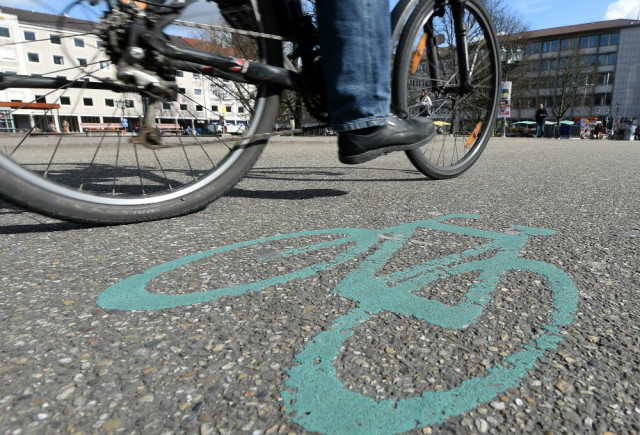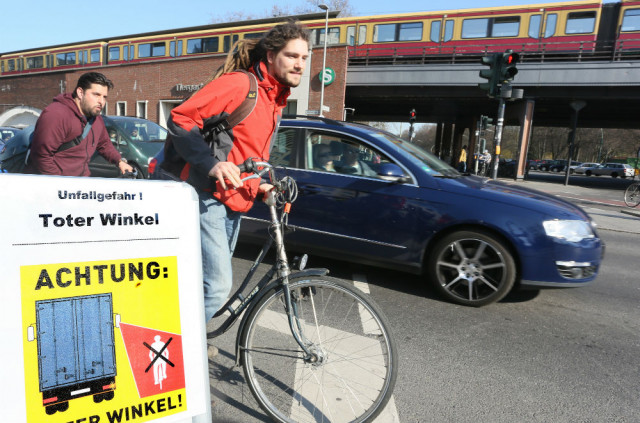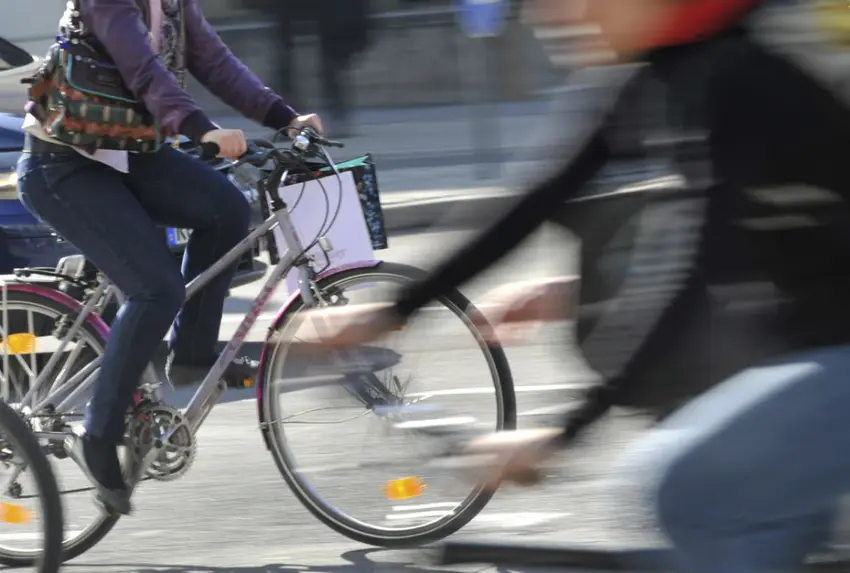While newcomers to Germany might be aware that riding one’s bike is a popular means of getting around, they may not know that there are rules which need to be followed - especially for one’s own safety.
Here are the top tips and rules of the road which bikers should be aware of, according to the German Road Safety Council (DVR) and the German Automotive Club (ADAC). Having lived in Germany for several years and commuted by bike in both medium-sized and large cities, I've sprinkled in some of my own suggestions too.
1. Overtake other bikers on the left
In Germany as in many other countries, just like motorists, cyclists ride on the right side of the road.
And while it might seem obvious to overtake other riders on the left - whether or not on dedicated bike paths - you'd be surprised how many cyclists stay in the middle or the left side of lanes.
Those who choose to cycle slowly should be considerate and stick close to the right of the bike lane - this enables others who are riding at a quicker pace to have enough room and to easily overtake them.
I've lost count of the number of times I’ve seen cyclists biking on the sidewalk in order to overtake slow riders, but technically this isn’t allowed as the sidewalks are meant for pedestrians.
2. Familiarize yourself with road signs
While the stop sign is recognized by most people regardless of the language they speak, other signs aren’t as universal.
For instance, wherever a yield sign is posted (a red and white upside down triangle), just like motorists, cyclists must give priority to other vehicles and wait. Other signs, such as the white and yellow one shaped like a diamond, conversely mean that drivers have to give you the right of way.
Another sign (number 254 in image) that’s circular and red and white with an image of a bicycle in the middle means that cyclists are prohibited from entering the street.
Conversely, if you see a blue sign with a white bike on it (237), you can be assured that the route is only for cyclists.
But if you see a blue sign that has another image on it (and no bike) then you are not allowed to enter (e.g. the sign with an image of a bus indicates that only buses may drive on the street).
3. Be aware of the “right before left” rule
Cycling has been my main means of transport for about five years now, and still something I witness every now and then is a cyclist nearly getting into an accident presumably because they don't know this rule.
At all intersections, the DVR states that the "right before left" rule applies, unless there are road signs or traffic lights that indicate otherwise. This means that motorists and cyclists alike must yield to traffic coming from the right side.
On smaller side streets, for instance, this rule can be seen in action. A typical situation could be that a cyclist riding along a street must stop every now and then due to cars coming from the right side at junctions.
Having grown up in Canada, this rule was slightly hard for me to get used to since most intersections which don't have traffic lights back home have stop signs, meaning that the "right before left" rule rarely applies.
4. Young children must cycle on the sidewalk
Young children are an exception when it comes to biking on the sidewalk, as they must do so until they are eight years old.
After this age, they have the option of biking alongside those on foot until their tenth birthday. But from then on they have to cycle on designated bike paths like everyone else.
5. Lights, brakes and a bell are a must
While wearing a helmet is recommended, there is no official obligation to wear one. Lights, breaks and a bell on the other hand are all mandatory.
Failing to comply with these rules can result in the police handing you a fine, according to the DVR. This means, for instance, if you choose to bike at night but your lights aren't working, don’t be surprised if a cop slaps you with a ticket.
In cities such as Münster in North Rhine-Westphalia, which was recently deemed Germany's most bike-friendly city, police have a keener eye on the offences committed by cyclists.
Family members of mine who live in Münster have told me that riders there often get fined for lack of a bike light, though I've yet to ever hear of anyone coughing up cash for lacking a bell.
Personally though, I don't see the bell rule as a bad thing. A bell is useful not only to alert pedestrians who unwittingly step onto the bike lane (and potentially force you to come to a screeching halt), but also to give fellow cyclists a heads up when you want to overtake them.
6. Do not cycle if you have drunk alcohol
As some of the points previously mentioned in this list highlight, oftentimes bike riders have to follow the same rules that vehicle drivers do - and refraining from driving while drunk is one of them.
If you are found with a blood alcohol level of 1.6 percent or more in your system, you can gather up to 3 points as well as receiving a fine. Similarly, you’re not allowed to call or text on your mobile phone while cycling.

A cyclist in Karlsruhe. Photo: DPA
7. Use hand signals to indicate turns
Using hand signals to show motorists and fellow bikers your intention to turn is not only courteous, it also avoids potentially dangerous situations such as a cyclist ramming into you from behind.
When turning, give a hand signal well in advance to indicate the direction in which you want to turn. If you want to turn right, it's as simple as holding your right arm straight up.
This might be strange to get used to for people from countries where hand signals for bikers are different. In Canada, for instance, holding up one’s left arm bent at a 90 degree angle indicates a right turn.
Remember too that pedestrians have priority when you're making a right turn, provided that their light at the pedestrian crossing is green.
8. Avoid dangerous situations like getting into drivers’ blind spots
When truck or car drivers are making a right turn, cyclists are at "particular risk" because they more often than not cannot be seen, states the ADAC.
Keep a good distance from vehicles to avoid getting in drivers’ blind spots, cycle defensively and if need be, get off your bike and move onto the sidewalk, suggests the DVR.
Establishing eye contact with the driver is also important in order to avoid getting into dangerous situations.
Automobiles at T-junctions and entrances to properties are other road situations that could pose a danger if you’re not biking cautiously.
 A sign at a Berlin intersection which warns bikers not to find themselves in motorists' blind spots. Photo: DPA
A sign at a Berlin intersection which warns bikers not to find themselves in motorists' blind spots. Photo: DPA9. Watch out for opening car doors
On streets where cars are parked to the right side of the bike lane, keep a good amount of distance from the parked cars. Some drivers open their car doors without regard for any passing cyclists; you can avoid the risk of getting badly hurt by anticipating their actions.
But it’s not just the cyclist’s job to ensure safety in this instance, states the ADAC.
Driving schools in the Netherlands teach learners to open the driver’s door from the inside using one’s right hand when exiting parked cars. This way, drivers do their part in being cautious as the movement forces them to use their upper body, turn slightly and check to see whether any cyclists are coming.
10. Remember: cyclists are “more vulnerable” than motorists
Even if you have priority in a traffic situation, for your own safety the ADAC suggests not to push it if you encounter another road user who isn’t abiding by the rules.
If for instance you have the right of way at an intersection and you notice a car is barrelling through with no intention of stopping, don't risk harming yourself and let the driver pass.
On the road, cyclists are "more vulnerable" than motorists, the automotive club states.

Comments